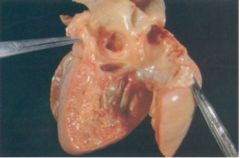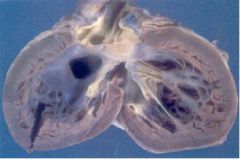![]()
![]()
![]()
Use LEFT and RIGHT arrow keys to navigate between flashcards;
Use UP and DOWN arrow keys to flip the card;
H to show hint;
A reads text to speech;
87 Cards in this Set
- Front
- Back
|
The most common cause of heart disease in children in the Western world
|
congenital heart disease
|
|
|
3 major groups of congenital heart disease
|
L to R shunt
R --> L shunt Obtructions |
|
|
cyanotic congenital heart disease is part of which group?
|
right to left shunt
|
|
|
infective endocarditis is common to which major group of congenital HD
|
all 3
|
|
|
the most common type of congenital malformation
|
left to right shunt
|
|
|
what specific malformations cause L to R shunts?
|
VSD, ASD, PDA
|
|
|
What is "tardive cyanosis"?
|
when a left to right shunt flow reverses
|
|
|
most common type of ASD (75%)
|
ostium secundum ASD
(septum secundum fails to cover the ostium scundum) |
|
|
second mos common type of ASD (15%)
|
ostium primum ASD
(septum primum does not fuse with endocardial cushion) |
|
|
least common type of ASD (10%)
|
sinus venosus ASD
|
|
|
where are sinus venosus ASDs?
|
high in the atrial septum
|
|
|
Inferior
(rare picture of both ostia in one heart) |

which is the ostium primum ASD?
|
|
|
most common congenital heart malformations diagnosed in adults
|
ASDs
(b/c many VSDs close spontaneously) |
|
|
Most common congenital heart malformations in general
|
VSDs
|
|
|
Ostium Primum ASDs are more likely assoc with CHF b/c of high frequency of _________ insufficiency
(partially) |
mitral
|
|
|
Clinical signs of ASD
|
- wide fixed split P2 with pulmonary flow murmur
- pulmonary vasculature normal to increased - Eisenmenger's syndrome |
|
|
Type of ASD that is well-tolerated, especially if it is less than 1cm diameter.
|
ostium secundum
(pulmonary HTN develops slowly and shunt reverses --> cyanosis) |
|
|
most common congenital heart lesion at birth
|
VSD
|
|
|
where are the basal (membranous) and muscular parts of the ventricular septum
|
Membranous part grows from endocardial cushions
Muscular part grows up from apex |
|
|
Site where 70% of VSDs are located
|
in the thinner membranous part of the septum
|
|
|
murmur type heard with VSD
|
pansystolic
|
|
|
genetic diseases associated with VSD
|
Trisomy 21, 13, 18
|
|
|
____% of VSD cases occur alone w/o other malfomations
|
30
|
|
|
___% of VSD pts develop Eisenmenger's snyndrome
|
10
|
|
|
small or medium sized VSDs that produce jet lesions have the risk of __________
|
superimposed infective endocarditis
|
|
|
The 6th most common congenital Heart disease :)
|
PDA
(10% of all cardiac malformations) |
|
|
What makes the ductus constrict after birth?
|
1-increased levels of arterial oxygen,
2-decreasing pulmonary vascular resistance, and 3-declining levels of prostaglandin E2 |
|
|
Membranous (basal)
|

What type of VSD
|
|
|
PDA is more common in females, T or F?
|
true
|
|
|
murmur heard with PDA
|
machine-like, continuous, waxing and waning
|
|
|
2 distinct presentations of PDA
|
1- premature infants in postnatal period
2- term infants at 3 months |
|
|
What would delay closure of the ductus after birth
|
hypoxia, resp. distress, heart disease
|
|
|
There is higher incidence of PDA in the presence of maternal _________ infection.
|
rubella
|
|
|
polycythemia is associated with what congenital heart disease?
|
PDA
|
|
|
Treatment of PDA
|
- surgical correction (cure)
- coil occlusion - indomethacin in premies (80% success) |
|
|
right to left shunts (4)
|
1- tetralogy of Fallot
2- transposition of the great vessels 3- tricuspid atresia 4- total anomalous pulonary venous connection (TAPVC) |
|
|
cyanotic heart defects at birth
|
the Ts and Truncus Arteriosus
|
|
|
Cyanotic heart defects after birth, when right-sided pressure increases
|
ASD, VSD, PDA
|
|
|
the most common cause of cyanotic heart disease
|
tetralogy of Fallot
|
|
|
The four components of the tetralogy are ________
|
(1) a VSD,
(2) a "dextraposed" aortic root that overrides the VSD, (3) right ventricular outflow obstruction, and (4) right ventricular hypertrophy |
|
|
What genetic disease is assoc. with Tetralogy of Fallot?
|
Down syndrome
|
|
|
What is the most likely lesion in a pt w/ right-sided arch and cyanosis
|
tetralogy of Fallot
|
|
|
Tetralogy of Fallot accounts for ____% of all congenital cardiac malformations
|
6
|
|
|
Shape of heart in tetralogy of Fallot
|
Boot-shaped
|
|
|
describe the proximal aortic root in tetralogy of Fallot
|
enlarged
|
|
|
describe pulmonary trunk in tetralogy of Fallot
|
small with narrowing or stenosis
|
|
|
When does pulmonary HTN start in Tetralogy of Fallot?
|
never
|
|
|
Effects of chronic cyanosis
|
-hyperviscosity secondary to erythrocytosis
-digital clubbing -systemic embolism |
|
|
the 2nd leading cause of cyanotic heart disease
|
transposition
|
|
|
patients with tetralogy of Fallot are also at increased risk for infective endocarditis, systemic emboli, and _________.
|
brain abscesses
|
|
|
the 2nd leading cause of cyanotic heart disease
|
transposition
|
|
|
patients with tetralogy of Fallot are also at increased risk for infective endocarditis, systemic emboli, and _________.
|
brain abscesses
|
|
|
treatment of transposition
|
prostaglandin E2, balloon septostomy and the creation of shunts, followed by definitive surgical correction
|
|
|
Truncus arteriosus is ___% of congenital heart malformations
|
2
|
|
|
Truncus arteriosus is a R to L shunt with heart failure and _________ infections
|
respiratory tract
|
|
|
Is truncus arteriosus correctable with surgery?
|
yes
|
|
|
complete occlusion of the tricuspid valve
|
tricuspid atresia
(not discussed in Robbins 7th ed) |
|
|
For tricuspid atresia to allow life, what malforamtions are present?
|
ASD, VSD (for the great artery communication in RV)
(not in Robbins 7th ed) |
|
|
Condition where no pulmonary veins directly join the left atrium
|
total anomalous pulmonary vascular connections
(TAPVC) |
|
|
Instead of from the pulmonary veins, the left atrium gets blood how?
|
Blood goes from coronary sinus --> to right atrium
--> ASD or patent foramen ovale --> Left atrium |
|
|
congeniatl obstructive lesions (2)
|
coarctation of aorta
valvular stenosis |
|
|
coarctation of the aorta is more common in the ____ gender and also _____ syndrome
|
male
Turner syndrome |
|
|
coarctaion of the aorta is associated with ______ aneurysms of the CNS
|
saccular
|
|
|
most common type of coarctation of aorta
|
post-ductal
|
|
|
narrowing of the aortic isthmus
|
preductal coarctation ("infantile")
|
|
|
type of aortic coarctation wherer ductus is patent
|
preductal
|
|
|
type of aortic coarctation with LVH
|
postductal
|
|
|
"Anomaly":
RV is enlarged and there is abnormal septal and posterior tricuspid leaflets |
Ebstein's anomaly
|
|
|
Ebstein's anomaly may be familial or associated with maternal _______ ingestion
|
lithium
|
|
|
condition that occurs with redundant and fenestrated leaflet
|
Ebstein's anomaly
|
|
|
condition that occurs with conduction abnormalities (Wolf-Parkinson-white syndrome)
|
Ebstein's anomaly
|
|
|
condition that causes atrialization of apical right ventricle
|
Ebstein's anomaly
|
|
|
treatment of Ebstein's anomaly
|
-valvuloplasty and RV reduction
-tricuspid valve replacement -ablation of conduction bypass pathways -antiarrythmia agents |
|
|
clinical presentation of Ebstein's anomaly
|
cyanosis
syncope CHF palpitation clubbing SCD |
|
|
13th most common CHD
|
hypoplastic left heart syndromes
|
|
|
a group of disorders characterized by underdeveloped left cardiac chambers
|
hypoplastic left heart syndromes
|
|
|
syndromes with marked cardiomegaly and increased pulmonary vascularity
Also, life depends on ductus areteriosus |
hypoplastic left heart syndromes
|
|
|
Clinical presentation of hypoplastic left heart syndromes
|
poor CO,
poor appetite and hypoglycemia, eventual IHD, acidosis, maybe shock |
|
|
treatment of hypoplastic left heart syndromes?
|
treat the acidosis and shock.
need surgery or transplant |
|
|
In severe cases the ostium primum defect is accompanied by a VSD and severe mitral and tricuspid valve deformities, with a resultant common ________
|
atrioventricular canal
|
|
|
69% of folks with atrioventricular canal have _______ syndrome
|
Down
|
|
|
heart is a mirror image of normal; sometimes assoc. with situs inversus
|
dextrocardia
|
|
|
3 types of congenital HD
|
L-R, R-L, obstruction
|
|
|
most common type (of 3) of Congenital HD
|
left to right shunts
|
|
|
what are right to left shunts due to?
|
the T's;
tetralogy, transposition, TA, TAPVC |
|
|
COndition with abnormal tricuspid valve leaflets
|
Ebstein's anomaly
|
|
|
an endocardial cushion defect with failure to form a variety of structures
|
AV canal
|

